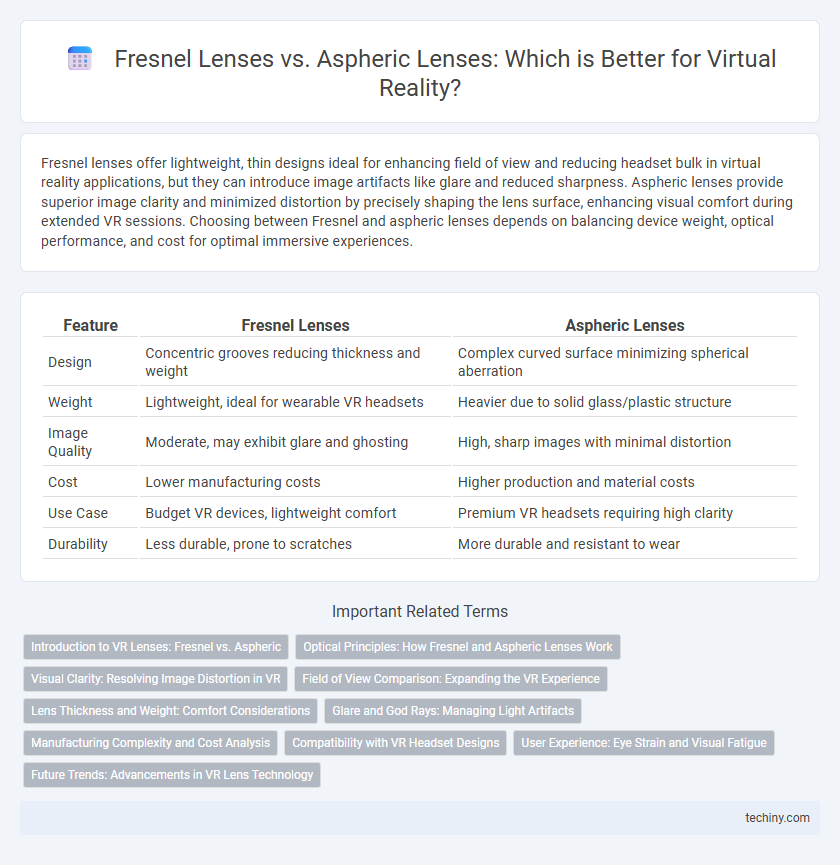Fresnel lenses offer lightweight, thin designs ideal for enhancing field of view and reducing headset bulk in virtual reality applications, but they can introduce image artifacts like glare and reduced sharpness. Aspheric lenses provide superior image clarity and minimized distortion by precisely shaping the lens surface, enhancing visual comfort during extended VR sessions. Choosing between Fresnel and aspheric lenses depends on balancing device weight, optical performance, and cost for optimal immersive experiences.
Table of Comparison
| Feature | Fresnel Lenses | Aspheric Lenses |
|---|---|---|
| Design | Concentric grooves reducing thickness and weight | Complex curved surface minimizing spherical aberration |
| Weight | Lightweight, ideal for wearable VR headsets | Heavier due to solid glass/plastic structure |
| Image Quality | Moderate, may exhibit glare and ghosting | High, sharp images with minimal distortion |
| Cost | Lower manufacturing costs | Higher production and material costs |
| Use Case | Budget VR devices, lightweight comfort | Premium VR headsets requiring high clarity |
| Durability | Less durable, prone to scratches | More durable and resistant to wear |
Introduction to VR Lenses: Fresnel vs. Aspheric
Fresnel lenses in VR headsets offer a lightweight design with reduced thickness, enhancing comfort and field of view but may introduce artifacts like glare and reduced image sharpness. Aspheric lenses provide superior image clarity and minimal distortion by precisely shaping the lens surface, improving overall visual fidelity for immersive VR experiences. Choosing between Fresnel and Aspheric lenses depends on balancing headset weight, optical performance, and cost considerations in VR device design.
Optical Principles: How Fresnel and Aspheric Lenses Work
Fresnel lenses utilize a series of concentric grooves to focus light by bending rays through thin, lightweight segments, enabling compact and efficient optical designs ideal for virtual reality headsets. Aspheric lenses feature non-spherical surfaces that correct optical aberrations, improving image clarity and reducing distortion by precisely directing light rays to a single focal point. The optical principle behind Fresnel lenses emphasizes minimizing material thickness for portability, while aspheric lenses prioritize enhanced visual performance through tailored curvature.
Visual Clarity: Resolving Image Distortion in VR
Fresnel lenses in VR headsets reduce weight and thickness but often introduce concentric ring artifacts that impact visual clarity and create image distortion. Aspheric lenses offer superior optical performance by minimizing spherical aberrations and providing sharper, clearer images without the distortion seen in Fresnel designs. Optimizing lens selection enhances user immersion by resolving visual artifacts and improving the fidelity of virtual environments.
Field of View Comparison: Expanding the VR Experience
Fresnel lenses in VR headsets provide a wider field of view by using concentric grooves that reduce bulk while maintaining lens diameter, enhancing peripheral vision and immersion. Aspheric lenses offer improved image clarity and reduced distortion but typically have a narrower field of view compared to Fresnel lenses. Choosing between Fresnel and aspheric lenses impacts the balance of visual sharpness and expansiveness, influencing the overall virtual reality experience.
Lens Thickness and Weight: Comfort Considerations
Fresnel lenses are significantly thinner and lighter than aspheric lenses, reducing the overall weight of virtual reality headsets and enhancing user comfort during extended use. The segmented design of Fresnel lenses allows for a compact form factor without compromising focal length, making them ideal for lightweight VR devices. In contrast, aspheric lenses tend to be thicker and heavier, which can cause increased pressure on the face and reduce comfort over long VR sessions.
Glare and God Rays: Managing Light Artifacts
Fresnel lenses often produce more glare and pronounced god rays due to their segmented surface structure, which scatters light unevenly and creates visible artifacts in virtual reality displays. Aspheric lenses minimize these light distortions by smoothly refracting light through a continuous curved surface, resulting in clearer visuals with reduced flare and halos. Optimizing VR headset optics with aspheric designs significantly enhances image quality by controlling unwanted light artifacts and improving user immersion.
Manufacturing Complexity and Cost Analysis
Fresnel lenses offer lower manufacturing complexity and cost due to their segmented, stepped design, which requires less material and simpler molding processes compared to aspheric lenses. Aspheric lenses demand precise shaping and polishing to achieve their smooth, curved surfaces, increasing production time and expenses significantly. This cost disparity makes Fresnel lenses a popular choice in virtual reality headsets aiming to balance optical performance with affordability.
Compatibility with VR Headset Designs
Fresnel lenses are widely favored in VR headset designs due to their thin, lightweight structure, enabling compact form factors and reducing overall device bulk. Aspheric lenses, though bulkier, offer superior optical clarity and reduced distortion, making them suitable for high-end VR headsets prioritizing visual fidelity. Compatibility depends on the desired balance between headset ergonomics and image quality, influencing manufacturers' choice between these lens types.
User Experience: Eye Strain and Visual Fatigue
Fresnel lenses in virtual reality headsets often lead to reduced eye strain due to their lightweight and thin design, which minimizes headset bulk and enhances comfort during extended use. Aspheric lenses provide a sharper, distortion-free image that can decrease visual fatigue by improving focus clarity and reducing the need for constant eye adjustment. Users typically experience less discomfort with aspheric lenses in prolonged VR sessions, while Fresnel lenses optimize wearability but may introduce slight glare or artifacts affecting long-term visual comfort.
Future Trends: Advancements in VR Lens Technology
Future trends in VR lens technology emphasize the integration of Fresnel and aspheric lenses to enhance image clarity and reduce distortion, improving immersive experiences. Advanced materials and manufacturing techniques are being developed to create lighter, more compact lenses that optimize focal length and field of view with minimal chromatic aberration. Ongoing research focuses on hybrid lens systems combining Fresnel's light weight and aspheric's precision, supporting higher resolution displays and wider viewing angles for next-generation VR headsets.
Fresnel lenses vs Aspheric lenses Infographic

 techiny.com
techiny.com